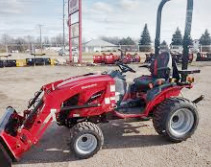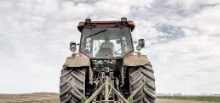________________________________________________________________________________________
| Home / Farm Tractors / Mahindra Tractors / Mahindra eMax 22 |
Mahindra eMax 22 Troubleshooting
 The
Mahindra eMax 22 sub-compact utility tractor was manufactured between 2014 and
2016. The Mahindra eMax 22 tractor is powered by Daedong 3C100LF 4-stroke
3-cylinder indirect injection naturally aspirated diesel engine. A 61.5 cubic
inches (1L) engine has a cylinder bore of 2.95" (75 mm), piston stroke of 2.99"
(76 mm), and rated power of 22 Hp (16.4 kW). The Mahindra eMax 22 is fitted with
a two transmission options: 6x2 gear transmission, or 2-range hydrostatic
transmission.
The
Mahindra eMax 22 sub-compact utility tractor was manufactured between 2014 and
2016. The Mahindra eMax 22 tractor is powered by Daedong 3C100LF 4-stroke
3-cylinder indirect injection naturally aspirated diesel engine. A 61.5 cubic
inches (1L) engine has a cylinder bore of 2.95" (75 mm), piston stroke of 2.99"
(76 mm), and rated power of 22 Hp (16.4 kW). The Mahindra eMax 22 is fitted with
a two transmission options: 6x2 gear transmission, or 2-range hydrostatic
transmission.
The maximum forward speed - 10.2 mph (16.4 km/h), maximum reverse speed - 10 mph (16 km/h). The open center hydraulic system includes a gear pump with rated fluid flow of 4.5 gal/min (17 l/min). The tractor is equipped with a hydrostatic power steering system, wet disc brakes, 6.00x12 front tyres, and 9.50x16 rear tyres. The wheelbase is 57.5 inches (1460 mm). The tractor is compatible with a 62" mid-mount 3-blade side discharge Mahindra M62 mower deck with cutting height of 1-4" (25-102 mm), and Mahindra eMax 25L front end-loader with a maximum lift height of 75" (1900 mm).
| Engine Troubleshooting |
| Engine difficult to start or doesn't start |
Air in the fuel pipes - Bleed the fuel pipes.
Fuel filter element clogging - Replace filter element.
Faulty or dirty injection nozzles - If necessary, replace with a new nozzle.
Water or dirt in fuel system - Drain, flush, and service the system.
Excessive valve clearance - Check and adjust.
Faulty fuel injection pump - Replace or repair injection pump.
| Engine starts but then stalls |
Intake air restriction - Air filter maintenance required.
Fuel filter plugging - Replace the filter element.
Fuel injection pump leakage - Check the fuel injection pump for leaks and fix it.
Damaged or clogged injectors - Replace fuel injectors.
Defective fuel injection pump - Replace or rebuild injection pump.
| Engine shuts off suddenly during operation |
Engine is cold - Warm up the engine.
Fuel filter element clogging - Change filter element.
There is air in the fuel system - Bleed the system.
Fuel injection nozzles are faulty or clogged - Service or change injection nozzles.
Wrong setting of fuel injection pump timing - Adjust fuel injection pump as required.
| Engine stalls when idle |
Incorrectly set low idle speed - Test and adjust.
Defective fuel injection pump - Repair or replace injection pump.
Clogged or defective injectors - Change or clean fuel injectors.
The valve clearance is not adjusted - Correct valve clearance needs to be set.
| Engine lacks power |
Air filter is dirty - Carry out maintenance on air filter.
Faulty fuel injection nozzles - Inspect nozzles and replace if necessary.
Improper fuel injection pressure - Check the fuel injection pressure and adjust if necessary.
Valve clearance is not correct - Adjustment procedure required.
Wrong adjustment of low idle speed - Adjustment required.
Fuel hoses or lines are dirty - Clean fuel system lines and hoses.
Cylinder head gasket is worn - Install a new gasket.
Worn or broken piston rings - Replace piston rings.
| Engine overheating |
Low coolant level - Top up coolant fluid and check system for leaks.
Engine oil level is low - Checking oil level and add if necessary.
Defective radiator cap or clogged radiator core - Replace cap or clean radiator.
Loose or damaged fan belt - Belt change is required.
Engine is under excessive load - Reduce engine load.
| Insufficient oil pressure |
Engine oil level low - Add oil as required.
Engine oil filter is plugged - Clean or change engine oil filter.
Improper type of engine oil - Use correct viscosity oil.
Crankshaft bearing oil clearance is excessive - Bearing needs to be changed.
Oil pump is worn or damaged - Inspect and change as required.
| Abnormal engine noise or knocking |
Engine oil level is low - Check oil level and add oil as required.
Engine is not fully warmed up - Normalize the temperature by warming up the engine.
Timing of fuel injection pump is incorrect - Adjust as recommended.
Wrong adjustment of low idle speed - Adjustment required.
Dirty or defective injectors - Clean fuel injectors or change it.
Misaligned or faulty connecting rod - Replace or align connecting rod.
Scored or worn pistons - Replace the pistons as required.
| Transmission Troubleshooting |
| Transmission oil pressure is low |
Insufficient transmission oil - Fill up the transmission oil.
Dirty transmission oil filter element (if equipped) - Clean or replace the transmission filter.
Stuck relief valve - Install a new relief valve.
| Transmission noise |
Insufficient transmission fluid - Add fluid to the transmission housing.
Transmission fluid is dirty - Fill up with fresh transmission fluid.
Backlash is incorrect or gears are damaged - Adjust backlash properly or replace the gears.
Bearings are broken or worn - Replace faulty bearings.
Damaged or worn gear shift forks - Replace the shift forks.
Damaged or worn shaft splines - Install a new shaft.
| Difficulty shifting gears |
Gear shift linkage is worn or rusty - Shift linkage need to be replaced.
Worn or bent gear shift forks - Replace the shift forks.
Gear shifting mechanism is defective - Defective parts must be replaced.
Worn or unadjusted clutch - Clutch needs to be adjusted or changed.
| Transmission fluid leaks |
Too much oil in transmission - Drain the excess oil.
Seals or gaskets are worn - Seals and gaskets need to be replaced.
| Hydrostatic Transmission Troubleshooting |
| Excessive hydrostatic transmission noise |
Fluid is contaminated or fluid level is insufficient - Fill to required level or change the fluid.
Worn or unadjusted speed control linkage - Repair or adjust linkage.
Defective relief valve - Replace the valve.
Excessive transmission load - Load needs to be reduced.
Defective or worn transmission parts - Replace or repair defective components.
| Low power |
Lack of transmission oil supply - Fill the transmission housing with oil.
Stuck relief valve - Replace relief valve.
Defective or not adjusted speed control pedal linkage - Adjust or replace linkage.
| Transmission fluid overheated |
Low fluid level - Need to add transmission fluid.
Transmission fluid filter element is clogged - Service or replace the transmission fluid filter.
Plugged or defective cooling components - Check all cooling components and clean or replace if required.
Excessive transmission load - Reduce transmission load.
| Transmission fluid leaks |
Damaged gaskets or seals - Gaskets or seal need to be replaced.
Internal transmission housing pressure is too high - Repair or replace damaged components.
Oil return tube is plugged - Clean or replace the tube.
| Hydraulic System Troubleshooting |
| Low hydraulic oil pressure |
Hydraulic fluid level low - Fill up the hydraulic fluid.
Hydraulic fluid filter element is clogged - Clean the hydraulic filter or install new filter element.
Hydraulic pump is faulty - Replace or repair hydraulic fluid pump.
Incorrect adjusted hydraulic spool valve - Adjust the spool valve correctly.
Hydraulic cylinder not working - Change or repair hydraulic cylinder.
Leaking hydraulic pipes - Identify leaks in the system and repair it.
| Hydraulic system overheats |
Defective main relief valve - Install a new relief valve.
Wrong hydraulic oil type - Fill up with the correct type of oil.
Hydraulic fluid contamination - Change hydraulic fluid.
Air trapped in hydraulic system - Bleed air from system.
| 3-point hitch can't lift or lifts too slowly |
Excessive load on hitch - Reduce the load is required.
Hydraulic fluid is insufficient - Checking hydraulic fluid level and add if necessary.
Dirty hydraulic oil filter element - Clean the hydraulic filter or install new filter element.
Hydraulic pump is faulty - Install a new hydraulic fluid pump.
Faulty main relief valve - Replace relief valve.
Defective hydraulic control valve block - Install a new valve or repair it.
Broken hydraulic cylinder - Change or repair hydraulic cylinder.
Suction pipe is disconnected or broken - Connect or replace pipe.
| Hitch won't drop or drops slowly |
Incorrect adjusted hydraulic control valve - Adjust correctly.
Hydraulic cylinder is broken - Replace or repair hydraulic cylinder.
Unadjusted hitch - Adjust three-point hitch as required.
Lift arm shaft is worn - Replace the shaft.
| Hitch lower or lift is jerky |
Air in hydraulic pipes - Bleed hydraulic pipes.
Dirty hydraulic fluid - The fluid must be changed.
Defective hydraulic pump - Replace or repair hydraulic oil pump.
Defective hydraulic control valve block - Change or repair hydraulic valve.
Faulty hydraulic cylinder - Change or repair hydraulic cylinder.
| Steering System Troubleshooting |
| Heavy steering |
Incorrectly fitted or worn steering column - Refit or replace the steering column.
Air lock in hydraulic steering system - Bleed air from system.
Incorrect toe-in - Adjust toe-in wheels.
Front tires wear unevenly - Change the tires.
Defective hydraulic steering pump - Repair or change steering pump.
Stuck or worn pump flow control valve - Clean or install new control valve.
Not enough steering fluid - Fill up steering fluid to required level.
| Steering wheel has too much free-play |
Steering column shaft or coupling is worn out - Replace faulty component.
Steering pump is worn - Install a new steering pump.
Worn or loose steering linkage assembly - Replace or repair steering linkage.
| Front wheels wander to right or left |
Uneven tire pressure - Inflate the tires properly.
Incorrect toe-in - Check and adjust toe-in.
Worn or loose steering linkage assembly - Change or repair steering linkage.
Improperly adjusted or defective front hub bearings - Replace or adjust the bearings correctly.
| Electrical Troubleshooting |
| Battery won’t charge |
Loose or corroded cable connections - Tighten or service connections.
Defective battery terminal clamps - Replace terminal clamps.
Dead cell in battery - Battery replacement required.
Worn or loose belt - Belt needs to be adjusted or changed.
| Starter cranks slow |
Low battery voltage - Recharge the battery.
Battery drains quickly - Service charging system or replace battery.
Faulty battery terminals or disconnected cables - Connect wiring correctly or install new terminals.
| Starter does not work |
Battery is discharged or defective - Recharge or change battery.
Wiring is improperly connected or disconnected - Check wiring and connect properly.
Battery power is low - Charge the battery.
Faulty starter motor - Repair or install a new starter.
________________________________________________________________________________________
________________________________________________________________________________________
| Farm Tractors Technical Specifications |
